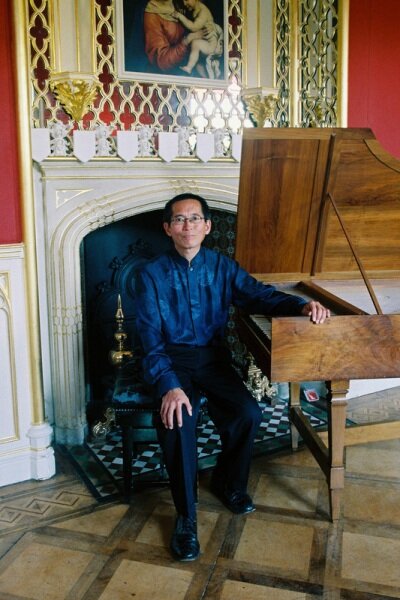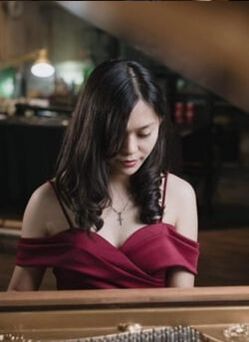Thursday
22nd September 2022
12.30 lunchtime
Agnes Chin
guzheng
Yeo Yat-Soon
harpsichord
First Encounters
Musical Journeys from the first Age of Globalisation
Programme
Traditional
published by Jean-Baptiste du Halde (1674-1743)
in Description de l'empire de Chine (1735)
Five 'Airs Chinois' Chinese Airs
Mozi (attrib) (5th Century BCE)
from Mozi Sings with Melancholy
Song
Giovanni Gabrieli (1557-1612)
from Canzoni per sonare (1608)
Canzon No 4
Mozi (attrib), same source
Song
Anon, (Qing Dynasty, 17th Century)
from Qingyin Shifan
Qiu Lai Autumn comes
Marco Facoli (c1540-1585)
from Secondo Libro d'Intavolatura (1588)
Aria della Comedia
Napoletana
Anon, (Qing Dynasty, 17th Century)
from Qingyin Shifan
Dong Lai Winter Comes
Loum Kiqua (fl 1750)
A Chinese Air (1757)
Two Chinese Songs (c1797)
The Peyho Boatmen
Moo Lee Chwa Jasmine Flower
arr William Hamilton Bird (fl 1790)
from The Oriental Miscellany; being a collection of the most favourite airs of Hindoostan, compiled and adapted for the Harpsichord (1789)
Rektah - Shushah myra bear
François Couperin (1668-1733)
from Quatrième Livre (1730)
Les Chinois The Chinese (People)
Jean-Philippe Rameau (1683-1764)
from Les Indes Galantes (1736)
Les Sauvages Savages
arr Jean Joseph Marie Amiot (1718-1793)
from Divertissements Chinois (1779) Chinese Amusements
Divertissement 1
Concert duration approx: 40 minutes
Please donate to help fund these concerts at: cafdonate.cafonline.org/14455
First Encounters
Musical Journeys from the first Age of Globalisation
Programme
Traditional
published by Jean-Baptiste du Halde (1674-1743)
in Description de l'empire de Chine (1735)
Five 'Airs Chinois' Chinese Airs
Mozi (attrib) (5th Century BCE)
from Mozi Sings with Melancholy
Song
Giovanni Gabrieli (1557-1612)
from Canzoni per sonare (1608)
Canzon No 4
Mozi (attrib), same source
Song
Anon, (Qing Dynasty, 17th Century)
from Qingyin Shifan
Qiu Lai Autumn comes
Marco Facoli (c1540-1585)
from Secondo Libro d'Intavolatura (1588)
Aria della Comedia
Napoletana
Anon, (Qing Dynasty, 17th Century)
from Qingyin Shifan
Dong Lai Winter Comes
Loum Kiqua (fl 1750)
A Chinese Air (1757)
Two Chinese Songs (c1797)
The Peyho Boatmen
Moo Lee Chwa Jasmine Flower
arr William Hamilton Bird (fl 1790)
from The Oriental Miscellany; being a collection of the most favourite airs of Hindoostan, compiled and adapted for the Harpsichord (1789)
Rektah - Shushah myra bear
François Couperin (1668-1733)
from Quatrième Livre (1730)
Les Chinois The Chinese (People)
Jean-Philippe Rameau (1683-1764)
from Les Indes Galantes (1736)
Les Sauvages Savages
arr Jean Joseph Marie Amiot (1718-1793)
from Divertissements Chinois (1779) Chinese Amusements
Divertissement 1
Concert duration approx: 40 minutes
Please donate to help fund these concerts at: cafdonate.cafonline.org/14455
Yeo Yat-Soon
|
Yeo Yat-Soon studied Music and Historical Musicology at King’s College London, and Harpsichord and Conducting the Guildhall School of Music, where he won the prestigious Raymond Russell Prize for Harpsichord.
He performs widely as a solo and ensemble harpsichordist. He plays with the ensembles Follia, The Stanesby Players and Camerata Berolinensis (Berlin). He also specializes in baroque opera and has conducted for London Baroque Opera, City of London Festival and Opéra de Baugé. He has broadcast for BBC1 and Channel 4 television, BBC Radio 3 and Classic FM. |
Yat-Soon has had a long association with music education, having been Director of Music at St Paul’s Girls’ School and the Lady Eleanor Holles School. He currently teaches harpsichord and lectures on Historical Performance at the University of Birmingham.
Agnes Chin
|
Agnes Chin was born in the Cameron Highlands of Malaysia.
She began learning the guzheng at the age of six, taking examinations with the China Central Academy of Fine Arts. She continued her guzheng studies at the Shanghai Conservatory of Music. Agnes also studied piano and flute at the Malaysian Institute of Arts in Kuala Lumpur. She has taught at the Ellen Music Academy in Subang Jaya and the Partita Music Academy in Kuala Lumpur. She is currently studying for a master’s degree in Piano Performance at the University of Birmingham. |
Guzheng
A Chinese plucked zither.
The modern guzheng commonly has 21, 25, or 26 strings, is 64 inches (1.6m) long and is tuned in a major pentatonic scale.
It has a large, resonant soundboard made from Paulownia wood. Other components are often made from other woods for structural or decorative reasons.
Guzheng players often wear fingerpicks, made from materials such as plastic, resin, tortoiseshell, or ivory, on one or both hands.
The short solo piece in the video below is called: 古筝-春江花月夜 Moonlit night with flowers on the Spring-time river.
The modern guzheng commonly has 21, 25, or 26 strings, is 64 inches (1.6m) long and is tuned in a major pentatonic scale.
It has a large, resonant soundboard made from Paulownia wood. Other components are often made from other woods for structural or decorative reasons.
Guzheng players often wear fingerpicks, made from materials such as plastic, resin, tortoiseshell, or ivory, on one or both hands.
The short solo piece in the video below is called: 古筝-春江花月夜 Moonlit night with flowers on the Spring-time river.
Recordings of the works in today's concert
It could be difficult to match precisely the sequence of Yat-Soon and Agnes' concert programme, so let us begin with them performing as a duo.
Air Chinois (published by Jean-Baptiste Du Halde, , Paris, 1735) and
Mo Li Hua (traditional and arranged by Karl Kambra, London, c.1794)
Air Chinois (published by Jean-Baptiste Du Halde, , Paris, 1735) and
Mo Li Hua (traditional and arranged by Karl Kambra, London, c.1794)
Giovanni Gabrieli (1557-1612)
from Canzoni per sonare (1608)
Canzon No 4
performed by Italian Wonderbrass in the Torre del Colle, Bevagna (Perugia) Italy)
from Canzoni per sonare (1608)
Canzon No 4
performed by Italian Wonderbrass in the Torre del Colle, Bevagna (Perugia) Italy)
Anon, (Qing Dynasty, 17th Century)
from Qingyin Shifan
Qiu Lai Autumn comes
Dong Lai Winter Comes
Here the Cleveland Chinese Music Ensemble, of Cleveland Ohio, perform the two songs together. The two lively pieces from the Qingyin shifan (清音十番) repertoire of banquet/entertainment music were formerly performed at the Qing Dynasty's summer palace/resort (承德避暑山庄) in the mountains of Chengde (承德市), Hebei province, northern China.
This music was preserved by the Chengde Qingyin Hui (承德清音会) following the dismissal of the Qing court musicians following the Xinghai Revolution of 1911.
Filmed live in concert at Carl F. W. Ludwig Recital Hall, Center for the Performing Arts, Kent State University, Kent, Ohio, United States, September 24, 2017.
Marco Facoli (c1540-1585)
from Secondo Libro d'Intavolatura (1588)
Aria della Comedia
Napoletana
The Aria is extremely short, so let us top up our experience of Facoli by hearing 3 more short pieces of his. Here are La Proficia, Napolitana, and Tedesaca dita L’Austria, performed by Wei Wang (percussion) and Hsiutsu Ryan.
from Secondo Libro d'Intavolatura (1588)
Aria della Comedia
Napoletana
The Aria is extremely short, so let us top up our experience of Facoli by hearing 3 more short pieces of his. Here are La Proficia, Napolitana, and Tedesaca dita L’Austria, performed by Wei Wang (percussion) and Hsiutsu Ryan.
|
|
|
Loum Kiqua (fl 1750)
Moo Lee Chwa Jasmine Flower
Is this gentle piece of violin playing Moo Lee Chwa? Maybe we should just enjoy it for what is is.
Moo Lee Chwa Jasmine Flower
Is this gentle piece of violin playing Moo Lee Chwa? Maybe we should just enjoy it for what is is.
arr William Hamilton Bird (fl 1790)
from The Oriental Miscellany; being a collection of the most favourite airs of Hindoostan, compiled and adapted for the Harpsichord (1789)
Rektah - Shushah myra bear
Harpsichord player Jane Chapman recorded a great deal of Bird's collection for Signum Records. The Western harpsichord gives an approximation of the sound of the original, although Chinese tuning would be different. In particular, microtones* are not available to us. (*the notes between the notes, in terms of pitch, rather than speed)
from The Oriental Miscellany; being a collection of the most favourite airs of Hindoostan, compiled and adapted for the Harpsichord (1789)
Rektah - Shushah myra bear
Harpsichord player Jane Chapman recorded a great deal of Bird's collection for Signum Records. The Western harpsichord gives an approximation of the sound of the original, although Chinese tuning would be different. In particular, microtones* are not available to us. (*the notes between the notes, in terms of pitch, rather than speed)
François Couperin (1668-1733)
from Quatrième Livre (1730)
Les Chinois The Chinese (People)
James Huntingford, harpsichord, in a version with Stella Huang playing the yangqin, a zither-like instrument. This recording comes from Perth City Hall, Western Australia.
from Quatrième Livre (1730)
Les Chinois The Chinese (People)
James Huntingford, harpsichord, in a version with Stella Huang playing the yangqin, a zither-like instrument. This recording comes from Perth City Hall, Western Australia.
Jean-Philippe Rameau (1683-1764)
from Les Indes Galantes (1736)
Les Sauvages Savages
It is just possible that this recording includes a lot of self-love. Still, when you are described as France's leading young barefoot harpsichordist.... yes, it's....
Jean Rondeau
alternatively, we have an ensemble performance from the Slovenian Baroque Orchestra and consort.
from Les Indes Galantes (1736)
Les Sauvages Savages
It is just possible that this recording includes a lot of self-love. Still, when you are described as France's leading young barefoot harpsichordist.... yes, it's....
Jean Rondeau
alternatively, we have an ensemble performance from the Slovenian Baroque Orchestra and consort.
|
|
|
arr Jean Joseph Marie Amiot (1718-1793)
from Divertissements Chinois (1779) Chinese Amusements
Divertissement 1
Our penultimate recording includes some description, some explanation, of the music we have been hearing in this selection. The list of performers he reads out is different from the one on youtube, but I can tell you that this comes from a concert celebrating the 85th anniversary of the National Taiwan University. In the first video, we hear the tune on violin. The second has the ensemble.
from Divertissements Chinois (1779) Chinese Amusements
Divertissement 1
Our penultimate recording includes some description, some explanation, of the music we have been hearing in this selection. The list of performers he reads out is different from the one on youtube, but I can tell you that this comes from a concert celebrating the 85th anniversary of the National Taiwan University. In the first video, we hear the tune on violin. The second has the ensemble.
|
|
|
|
Selection of Music Videos
remembering our dear late Queen Elizabeth II |
Previous concert
Catriona Borne-Swinton-Hunter, flute & Raymond Yiu, piano - click here
Next Thursday's concert
Louisa Till, violin, & Oliver Till, piano - click here










